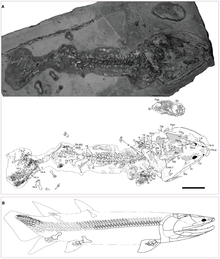Tinirau (genus)
|
Tinirau Temporal range: Middle Devonian, 387 Ma |
|
|---|---|
 |
|
| Holotype fossil and interpretive drawing of Tinirau clackae | |
| Scientific classification | |
| Kingdom: | Animalia |
| Phylum: | Chordata |
| Class: | Sarcopterygii |
| Clade: | Tetrapodomorpha |
| Clade: | Eotetrapodiformes |
| Genus: |
†Tinirau Swartz, 2012 |
| Type species | |
|
†Tinirau clackae Swartz, 2012 |
|
Tinirau is an extinct genus of sarcopterygian fish from the Middle Devonian of Nevada. Although it spent its entire life in the ocean, Tinirau is a stem tetrapod close to the ancestry of land-living vertebrates in the crown group Tetrapoda. Relative to more well-known stem tetrapods, Tinirau is more closely related to Tetrapoda than is Eusthenopteron, but farther from Tetrapoda than is Panderichthys. The type and only species of Tinirau is T. clackae, named in 2012.
Tinirau shares many advanced features with later tetrapodomorphs in the pelvic limb bones and glenoids (shoulder sockets). By the time Tinirau appeared, many stem tetrapods had already developed the three major hindlimb bones of tetrapods: the femur, tibia, and fibula. While derived stem tetrapods like Panderichthys had hindlimb configurations very similar to the first land-living tetrapods, some early forms such as Eusthenopteron possessed a prominent postaxial process of the fibula hanging over the fibulare bone below it. Tinirau is the earliest known stem tetrapod to have a significantly reduced postaxial process, and a fibula more like those of later tetrapods.
Like those of the Late Devonian Panderichthys and Ichthyostega, the glenoid of Tinirau is elongated along the anteroposterior (forward-backward) axis of the body. The lengthening of the glenoid corresponds with a flattening of the proximal end of the humerus, a feature common in the forelimbs of more advanced stem tetrapods. Although the pectoral limb bones and girdle were not strong enough to support the weight of Tinirau out of water, glenoid lengthening and other changes to the proximal forelimb were among the first steps in the transformation from pectoral fin to forelimb.
...
Wikipedia
